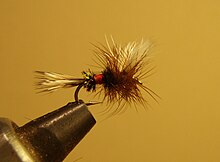Origin
The adoption of the hairwing patterns that eventually became the Wulff dry fly style began in the late 1920 in several locations. Although many angling writers credit Lee Wulff with the Royal Wulff, Q. L. Quackenbush, an early member of the Beaverkill Trout Club above Lew Beach in New York is often cited as the creator. In 1929–30 both Quackenbush and Wulff had independently modified the Royal Coachman pattern, particularly the Fanwing Royal Coachman with hair wings and tails. Both Wulff and Quackenbush made the modifications because the Fanwing Royal Coachman proved too flimsy and fragile on rough water. The first Quackenbush versions were tied commercially by Rube Cross and were named Quack Coachman, Hair-winged Royal Coachman and Quack Special. [3]
In the 1930s Lee Wulff collaborated with Dan Bailey during the development of his hairwing patterns and Bailey encouraged him to rename the flies. The original Ausable Gray, Coffin May and Bucktail Coachman became the Grey Wulff, White Wulff and Royal Wulff. Three additional patterns were created by the end of 1930, the Blonde Wulff, Brown Wulff and Black Wulff. The series would gain prominence after Wulff introduced them to Ray Bergman, another fly angler and outdoor writer who became the Fishing editor for Outdoor Life magazine. Bergman embraced the flies and included them his two editions of Trout (1938, 1952). [4]
The Wulff flies were designed by Lee Wulff and fill a decided need in large sizes. I consider them necessary to the well-balanced fly box. New Wulff patterns, Black Wulff and Grizzly Wulff [designed by Dan Bailey] have been added to my color plates because they are considered very important by fishermen in the Rockies as well as other sections.
—
Ray Bergman, Trout (1952) [5]
Wulff considered the pattern somewhat generic and encouraged variation and evolution of the pattern instead of rigid adherence to a precise recipe. Dan Bailey, who fished regularly in Montana and eventually established a fly shop and mail order business in Livingston, Montana, in 1938 promoted the series extensively to western fly anglers.
The Wulff flies, especially the Royal Wulff, are still a staple in angler's fly boxes around the world. [6] Angler and writer John Gierach believes the Royal Wulff is one of the most popular dry patterns over the last half century. [7]

Fly tying is the process of producing an artificial fly used by fly fishing anglers to catch fish. Fly tying is a manual process done by a single individual using hand tools and a variety of natural and manmade materials that are attached to a hook. Although the recent history of fly tying dates from the middle 1800s, fly tyers were engaged in tying flys since at least 200 AD.

The Muddler Minnow is a popular and versatile artificial fly of the streamer type used in fly fishing and fly tying.
Dry fly fishing is an angling technique in which the lure is an artificial fly which floats on the surface of the water and does not sink below it. Developed originally for trout fly fishing, it is sometimes regarded as the supreme fishing sport, owing to its difficulty in both manual dexterity and understanding of the fish in its environment.

The Clouser Deep Minnow is an artificial fly commonly categorized as a streamer and is fished under the water surface. It is a popular and widely used pattern for both freshwater and saltwater game fish and is generally listed as one of the top patterns to have in any fly box, especially for bass and saltwater flats fishing.

An artificial fly or fly lure is a type of fishing lure, usually used in the sport of fly fishing. In general, artificial flies are an imitation of aquatic insects that are natural food of the target fish species the fly fishers try to catch. Artificial flies are constructed by fly tying, in which furs, feathers, thread or any of very many other materials are tied onto a fish hook.

The Grey Ghost Streamer is an artificial fly, of the streamer type. Its primary function is to imitate smelt. The streamer's wing gives it a swimming action while trolling or using the Dead Drift technique.
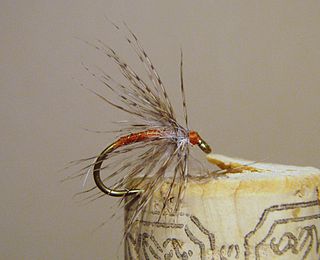
The Partridge and Orange is an artificial fly commonly categorized as a wet fly or soft hackle and is fished under the water surface. The fly is a very well known fly with its roots set firmly in English angling history. It is an impressionistic pattern fished successfully during caddis hatches and spinner falls. The Partridge and Orange is traditionally a trout and grayling pattern but may be used for other aquatic insect feeding species.

The Royal Coachman is an artificial fly that has been tied as a wet fly, dry fly and streamer pattern. Today, the Royal Coachman and its variations are tied mostly as dry flies and fished floating on the water surface. It is a popular and widely used pattern for freshwater game fish, particularly trout and grayling. Large streamer versions are also used for winter steelhead and Atlantic salmon.
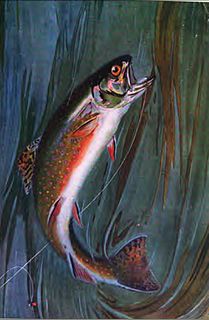
This annotated bibliography is intended to list both notable and not so notable works of English language, non-fiction and fiction related to the sport of fly fishing listed by year published. Although 100% of any book listed is not necessarily devoted to fly fishing, all these titles have significant fly fishing content. Included in this bibliography is a list of species related fly fishing literature.
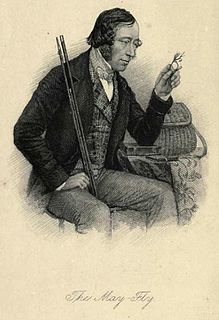
This annotated bibliography is intended to list both notable and not so notable works of English language, non-fiction and fiction related to the sport of fly fishing listed by year published. Although 100% of any book listed is not necessarily devoted to fly fishing, all these titles have significant fly fishing content. Included in this bibliography is a list of fly tying, fly tackle, regional guides, memoirs, stories and fly fishing fiction related literature.
Lee Wulff, born Henry Leon Wulff, was an artist, pilot, fly fisherman, author, filmmaker, outfitter and conservationist who made significant contributions to recreational fishing, especially fly fishing and the conservation of Atlantic Salmon.

The Elk Hair Caddis is a dry fly commonly used for trout fishing. The Elk Hair Caddis was created by Pennsylvania fly tyer Al Troth in 1957. He is considered a pioneer in the sport of fly fishing for this invention.

The Adams is a traditional dry fly primarily used for trout. It is considered a general imitation of an adult mayfly, flying caddis or midge. It was designed by Leonard Halladay from Mayfield, Michigan in 1922, at the request of his friend Charles Adams. The Adams has been considered one of the most popular, versatile, effective and best selling dry flies since its creation.
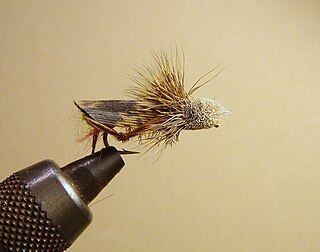
Dave's Hopper is an artificial fly used for fly fishing, designed to imitate adult grasshoppers and other Orthoptera species. It is considered a dry fly terrestrial pattern. It was designed by fly tyer and angler Dave Whitlock, and combines the best aspects of Joe's Hopper and Muddler Minnow patterns.

The Stimulator is a dry fly popularized by angler, fly tyer and author Randall Kaufmann to imitate large adult stoneflies.

The Wulff series of dry flies evolved from a dry fly style conceived by angler Lee Wulff in the 1930s.

The Brown Bi-visible is an attractor style dry fly. The addition of light cream colored or white hackle at the front of the darker body made the Bi-visible easier for the angler to see on the water. Ray Bergman in his seminal 1952 work Trout gave the following credit to the Bi-visible pattern:
I gave Bivisible flies complete and indisputable credit. I believe that I even intimated they were the last word--the ultimate in dry flies. I was so sold on the Bivisibles for one complete season that if trout wouldn't take one, I figured they wouldn't take anything, and I was perfectly satisfied with this decision.

The Humpy fly is a popular and effective dry fly used by fly anglers for trout in fast-water conditions.
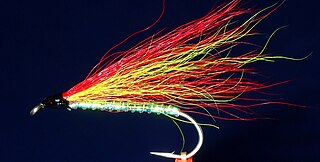
The Mickey Finn is a historic and effective bucktail streamer used by fly anglers for trout, warm-water and saltwater species. The fly is somewhat generic and imitates a wide variety of baitfish. Although most likely originated in the late 19th century by Eastern Canadian anglers, the Mickey Finn pattern once known as the Red and yellow bucktail was popularized by angler and author John Alden Knight in 1937.

Terrestrial flies are a broad group of artificial flies used by fly anglers to imitate terrestrial insects that fall prey to fish in rivers, streams and lakes. Most typical are patterns imitating grasshoppers, crickets, ants, beetles, leaf hoppers, cicadas and moths.
This page is based on this
Wikipedia article Text is available under the
CC BY-SA 4.0 license; additional terms may apply.
Images, videos and audio are available under their respective licenses.
